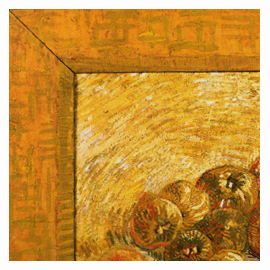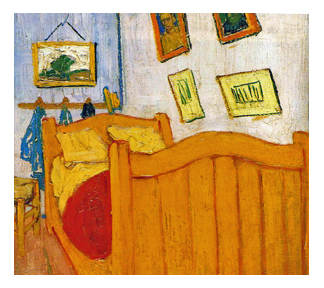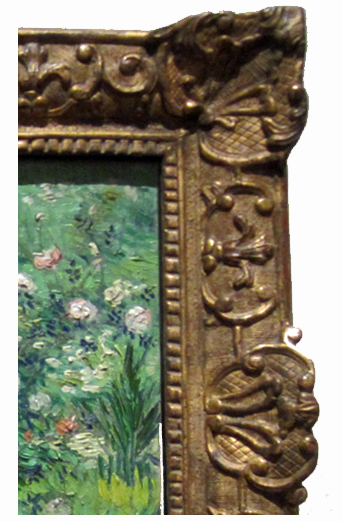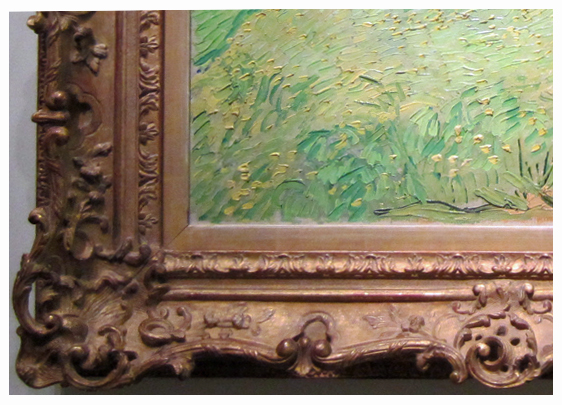Framing Van Gogh
2012 exhibit at the Philadelphia Museum of Art
During his life time (1853-1890) Vincent Van Gogh sold one painting, very few of his canvases were ever mounted in frames. He gave a lot of thought to framing but given the expense and lack of space could not. At one point Vincent suggested to his brother Theo that perhaps some of his portrait studies could be glued to gold Bristol board. He didn’t feel they warranted the investment of a frame.

At first he was inclined to use small black frames but after seeing the framing choices of his contemporaries in Paris Vincent experimented with white and color on plain moldings. The only surviving frame that Van Gogh painted is in the Van Gogh Museum, Amsterdam. Above is a picture taken from the book “In Perfect Harmony” of that frame. It is painted with layers of thick pigment in shades of yellow in a rough grid pattern. The bevel was initially red but painted over as the color was probably deemed to be better as a neutral.

In 1888 Van Gogh decided to decorate his room in Arles with his own paintings. He made frames that matched the humble nature of his furnishings. By simply chasing a strip of unfinished oak around the paintings as you can see in this detail of “The Bedroom”.

The paintings in Vincent’s brother Theo’s apartment were displayed either unframed, or with white or unfinished wood frames. When Theo died unexpectedly, his wife Johanna moved back to Holland and set out to bring public attention to Vincent’s work by arranging exhibitions. The expense of framing an entire exhibit was very high and dealers did not want to invest at this point so the paintings were displayed without. In 1892 for a retrospective in Amsterdam the Society pour L’Art provided 52 flat white frames. In 1931 the bulk of the collection, inherited by Vincent’s grandson was permanently loaned to the Stedelijk Museum in Amsterdam. Most were given a fairly uniform conventional molding. When the paintings were put in secure storage during World War II they were taken out of the frames and put in transportation frames made of simple wood stripping. These simple, utilitarian surrounds were pleasing to museum curators as they asserted Van Gogh’s role as forerunner of modern art so they were left on for permanent display.

By the early 20th century as Van Gogh’s reputation began to soar. Dealers and collectors started using Louis XIV and XV style frames to display his paintings. Bright gold was deemed incompatible with the Van Gogh colors so most of the gold was rubbed off exposing the gesso below. Then an off white tone was washed over the frame. This practice of using old frames for new paintings was started in the late 19th century by the early Impressionist painters like Monet. Often a linen or painted liner was placed between the painting and the frame. Original frames or carefully crafted, gilded reproductions became the popular choice by dealers and museums for framing Van Gogh paintings.

A notable exception is on “Grapes, Lemons, Pears and Apples” which is framed in a white fluted convex molding after designs by Edgar Degas.

Another painting “Park of the Asylum as Saint-Remy” is framed in a wide Dutch black lacquer with ripple.

Several paintings were mounted in the frame style above. This is my personal favorite because it gives enough presence without being frilly.
The bolection shape and crude carving is similar to a 17th century Spanish molding but with the ribbon and leaf pattern of a Louis XIII frame. This is probably a 20th C. hybrid although it’s hard to date frames without seeing the back sides. Most have been refinished multiple times and many period frames are copied for literally hundreds of years.

Other paintings including “Garden in Auvers” are tastefully placed in very wide but uncarved moldings, finished in muted gold leaf.

The “correct” way to frame Van Gogh paintings is to this day being debated. In 1905, the son of collector Paul Gachet, condemning the ornate frames made this observation ”It is an act of barbarism to put gold frames around Vincent’s canvases, that simple man who, out of modesty, did not even sign his own canvases.
Information for this article from “In Perfect Harmony, Picture+ Frame” Van Gogh Museum.
